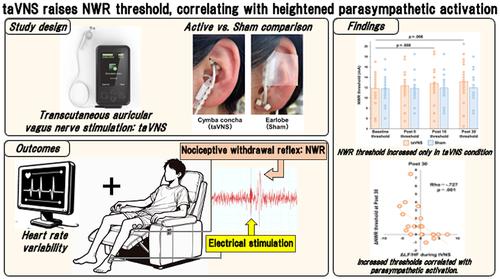当前位置:
X-MOL 学术
›
Eur. J. Nerosci.
›
论文详情
Our official English website, www.x-mol.net, welcomes your feedback! (Note: you will need to create a separate account there.)
Effects of transcutaneous auricular vagus nerve stimulation at left cymba concha on experimental pain as assessed with the nociceptive withdrawal reflex, and correlation with parasympathetic activity
European Journal of Neroscience ( IF 3.4 ) Pub Date : 2024-03-12 , DOI: 10.1111/ejn.16305 Hirotake Yokota 1, 2 , Mutsuaki Edama 1, 2 , Yurika Kawanabe 2 , Ryo Hirabayashi 1, 2 , Chie Sekikne 1, 2 , Hiroshi Akuzawa 1, 2 , Tomonobu Ishigaki 1, 2 , Naofumi Otsuru 1, 2 , Kei Saito 1, 2 , Sho Kojima 1, 2 , Shota Miyaguchi 1, 2 , Hideaki Onishi 1, 2
European Journal of Neroscience ( IF 3.4 ) Pub Date : 2024-03-12 , DOI: 10.1111/ejn.16305 Hirotake Yokota 1, 2 , Mutsuaki Edama 1, 2 , Yurika Kawanabe 2 , Ryo Hirabayashi 1, 2 , Chie Sekikne 1, 2 , Hiroshi Akuzawa 1, 2 , Tomonobu Ishigaki 1, 2 , Naofumi Otsuru 1, 2 , Kei Saito 1, 2 , Sho Kojima 1, 2 , Shota Miyaguchi 1, 2 , Hideaki Onishi 1, 2
Affiliation

|
The aim of this study was to clarify the effects of transcutaneous auricular vagus nerve stimulation (taVNS) to the left cymba concha on the pain perception using nociceptive withdrawal reflex (NWR), which is known to be associated with chronic pain, and to investigate whether there is a relationship between taVNS‐induced suppression of the NWR and parasympathetic activation. We applied either 3.0 mA, 100 Hz taVNS for 120 s on the left cymba concha (taVNS condition) or the left earlobe (Sham condition) for 20 healthy adults. NWR threshold was measured before (Baseline), immediately after (Post 0), 10 min (Post 10) and 30 min after (Post 30) stimulation. The NWR threshold was obtained from biceps femoris muscle by applying electrical stimulation to the sural nerve. During taVNS, electrocardiogram was recorded, and changes in autonomic nervous activity measured by heart rate variability (HRV) were analyzed. We found that the NWR thresholds at Post 10 and Post 30 increased compared with baseline in the taVNS group (10 min after: p = .008, 30 min after: p = .008). In addition, increased parasympathetic activity by taVNS correlated with a greater increase in NWR threshold at Post 10 and Post 30 (Post 10: p = .003; Post 30: p = .001). The present results of this single‐blinded study demonstrate the pain‐suppressing effect of taVNS on NWR threshold and suggest that the degree of parasympathetic activation during taVNS may predict the pain‐suppressing effect of taVNS after its application.
中文翻译:

左耳甲经皮耳迷走神经刺激对实验性疼痛的影响(通过伤害性撤退反射评估)以及与副交感神经活动的相关性
本研究的目的是通过已知与慢性疼痛相关的伤害性撤退反射 (NWR) 阐明经皮耳迷走神经刺激 (taVNS) 对左耳甲的疼痛感知的影响,并调查是否taVNS 诱导的 NWR 抑制与副交感神经激活之间存在关联。我们对 20 名健康成年人的左耳甲(taVNS 条件)或左耳垂(假条件)应用 3.0 mA、100 Hz taVNS 120 秒。在刺激前(基线)、刺激后立即(后 0)、刺激后 10 分钟(后 10)和刺激后 30 分钟(后 30)测量 NWR 阈值。NWR 阈值是通过对腓肠神经施加电刺激从股二头肌获得的。在taVNS期间,记录心电图,并分析通过心率变异性(HRV)测量的自主神经活动的变化。我们发现,与 taVNS 组的基线相比,10 后和 30 后的 NWR 阈值有所增加(10 分钟后:p = .008,30 分钟后:p =.008)。此外,taVNS 增加的副交感神经活动与 10 后和 30 后 NWR 阈值的更大增加相关(10 后:p = .003;帖子 30:p = .001)。这项单盲研究的当前结果证明了 taVNS 对 NWR 阈值的镇痛作用,并表明 taVNS 期间副交感神经的激活程度可以预测 taVNS 应用后的镇痛效果。
更新日期:2024-03-12
中文翻译:

左耳甲经皮耳迷走神经刺激对实验性疼痛的影响(通过伤害性撤退反射评估)以及与副交感神经活动的相关性
本研究的目的是通过已知与慢性疼痛相关的伤害性撤退反射 (NWR) 阐明经皮耳迷走神经刺激 (taVNS) 对左耳甲的疼痛感知的影响,并调查是否taVNS 诱导的 NWR 抑制与副交感神经激活之间存在关联。我们对 20 名健康成年人的左耳甲(taVNS 条件)或左耳垂(假条件)应用 3.0 mA、100 Hz taVNS 120 秒。在刺激前(基线)、刺激后立即(后 0)、刺激后 10 分钟(后 10)和刺激后 30 分钟(后 30)测量 NWR 阈值。NWR 阈值是通过对腓肠神经施加电刺激从股二头肌获得的。在taVNS期间,记录心电图,并分析通过心率变异性(HRV)测量的自主神经活动的变化。我们发现,与 taVNS 组的基线相比,10 后和 30 后的 NWR 阈值有所增加(10 分钟后:



























 京公网安备 11010802027423号
京公网安备 11010802027423号